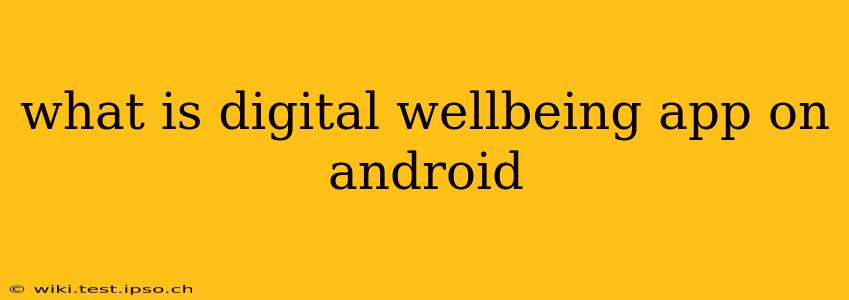Digital wellbeing apps on Android are tools designed to help users understand and manage their smartphone usage. They provide insights into how much time you spend on different apps, websites, and features, ultimately empowering you to create healthier digital habits. Instead of simply being a productivity tool, they focus on promoting a balanced relationship with technology, preventing overuse and promoting mindful engagement. Think of them as your personal digital health coach, providing data and tools to help you achieve a healthier digital lifestyle.
What are the key features of digital wellbeing apps?
Most digital wellbeing apps offer a range of features, although the specific offerings vary depending on the app. Common features include:
- App Usage Tracking: This core feature provides detailed information about how much time you spend on each app. You'll see daily, weekly, and even monthly breakdowns, allowing you to pinpoint time-consuming apps or activities.
- Usage Limits: Many apps let you set daily usage limits for specific apps. Once you hit your limit, the app will notify you, helping you stay aware of your usage.
- Focus Mode/Do Not Disturb: These features allow you to temporarily disable notifications and limit app access for periods of time dedicated to work, study, or relaxation.
- Wind Down Mode: This feature helps you prepare for sleep by gradually dimming your screen and reducing blue light emission. It can also schedule Do Not Disturb for nighttime hours.
- App Usage Summaries and Reports: Visual representations of your app usage, often in the form of graphs and charts, make it easy to understand your digital habits at a glance.
- Customizable Dashboards: These let you personalize what information is displayed, focusing on the data that matters most to you.
- Notification Controls: These allow you to manage and prioritize notifications, reducing interruptions and promoting focus.
How can I find and use a digital wellbeing app?
Android phones typically come pre-installed with a Digital Wellbeing app, often integrated with features like Focus Mode and Wind Down. This built-in functionality is a great starting point. To access it, simply search for "Digital Wellbeing" or "Digital Wellness" in your phone's settings.
There are also many third-party digital wellbeing apps available on the Google Play Store. These often offer more advanced features and customization options, but it’s important to carefully review user reviews before downloading and using them. Remember to look for apps that prioritize your privacy and data security.
What are the benefits of using a digital wellbeing app?
The benefits of using digital wellbeing apps extend beyond just tracking your usage. They help you:
- Become more self-aware: Understanding your digital habits is the first step to changing them.
- Reduce screen time: By setting limits and using focus modes, you can significantly reduce your overall screen time.
- Improve sleep quality: Wind Down mode can promote better sleep hygiene by reducing screen time before bed.
- Boost productivity: By minimizing distractions, you can improve focus and concentration on tasks.
- Reduce stress and anxiety: Taking breaks from technology can help reduce feelings of overwhelm and improve mental wellbeing.
Are there any downsides to using a digital wellbeing app?
While digital wellbeing apps offer many benefits, there are some potential downsides:
- Over-reliance on technology to manage technology: The app itself could become another source of stress if you feel you're constantly monitoring your usage. The goal is to find balance, not to become overly fixated on numbers.
- Data Privacy Concerns: Some apps collect and analyze your usage data. It's crucial to choose an app with a strong privacy policy that you trust.
- Potential for Gamification Issues: While gamified features can be motivating, they can also lead to unhealthy competition or obsession with achieving goals.
Which digital wellbeing app is best for me?
The best digital wellbeing app depends on your individual needs and preferences. Some users might find the built-in Android Digital Wellbeing app sufficient, while others might prefer the advanced features offered by third-party apps. Experiment with a few different options to find the one that fits your lifestyle and helps you achieve your digital wellbeing goals. Reading user reviews and comparing features is highly recommended.
